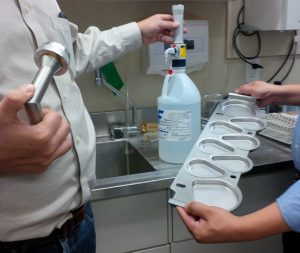Going into its 8th year, the annual Aerosol School at McMaster University in Hamilton, Ontario, Canada has added several new topics while continuing to provide a comprehensive basic education in aerosol medicines, says founder Myrna Dolovich. In addition to instruction in OINDP devices, formulation, and testing methods, the school curriculum is keeping up with recent trends and providing a glimpse into the future by adding instruction in areas such as human factors, nasal delivery of peptides, and nanomedicine.
 Co-sponsored by the McMaster University Firestone Institute for Respiratory Health, St. Joseph’s Healthcare, and the International Society for Aerosols in Medicine (ISAM), the 2016 Aerosol School will take place October 5-7.
Co-sponsored by the McMaster University Firestone Institute for Respiratory Health, St. Joseph’s Healthcare, and the International Society for Aerosols in Medicine (ISAM), the 2016 Aerosol School will take place October 5-7.
Each year the school, which offers a series of lectures and hands-on workshops over the course of three days, enrolls approximately 20 students from a variety of backgrounds and countries. Attendees include new hires at pharmaceutical companies, clinicians, graduate students, and regulators who want an understanding of the basics of aerosol medicine to inform their reviews of applications for OINDPs.
Aerogen Chief Scientific Officer Jim Fink, who has taught at Aerosol School since its inception in 2009 notes that with a 2/1 student-to-faculty ratio and a good deal of time spent with the instructors in small labs and at meals, students get an unparalleled opportunity to develop relationships with industry experts, including Jolyon Mitchell, NGI impactor inventor Daryl Roberts, Allergan Senior Director of Pharmaceutical Development Kevin Stapleton, Catalent Manager of Pulmonary and Nasal Development Lei Mao, all of whom have been on the faculty since the first year. “The faculty are all stellar,” Dolovich says, noting that all are excellent presenters in addition to having wealths of knowledge and experience.
Fink says that he returns year after year because he learns as much at Aerosol School – from both his fellow instructors and the students – as at most conferences. “All sorts of new questions come up,” he explains, “and the curriculum’s fairly dynamic; we try to modify it from year to year to meet perceived needs of the people who are coming.”
“The mix of students is part of what makes the program successful,” he adds, “because everyone has something to add through their expertise; the people who come to the table to learn also have a lot to share and teach and it makes a great interaction.”
Bearing in mind that the people who come to the school are just beginning to learn about OINDPs and are looking for a comprehensive introduction to the field, Dolovich notes, the faculty still make an effort to introduce new trends in aerosol medicine: “We try to be current up to a point and we incorporate newer ideas into the talks.”
Over the past few years, Dolovich says, the school has expanded its coverage of nasal delivery, both in talks on formulation and the inclusion of more devices in the hands-on device workshop. The lab has also added the ability to sample from a nasal pump for cascade impaction.
Helen Neighbour, a clinician and researcher in the Department of Medicine at McMaster who joined the faculty last year will discuss nasal delivery to patients. A talk on the nasal delivery of peptides is also being added, which will also naturally lead to a discussion of nose-to-brain delivery, Dolovich adds.
Responding to the growing importance of human factors engineering in regulatory approval for OINDP, the school is offering a human factors workshop for the third year. In this exercise, students break up into small groups and each examines an inhaler’s risk, in terms of both manufacturing and patient use.
A new lecture on nanomedicine will be presented by Heidi Mansour from the University of Arizona. “That’s an area that is growing,” Dolovich points out, “but is still not a target for inhaled therapies quite yet though there is obviously some interest and people are working in the field but there’s nothing on the market yet other than e-cigarettes that would fall into that category.”
Although older topics are displaced from the 3-day program, Fink says, materials from past presentations are still included in the book that students receive at the end of the course. Students also receive a 1-year membership in ISAM.
For more information about Aerosol School and registration, click here.


